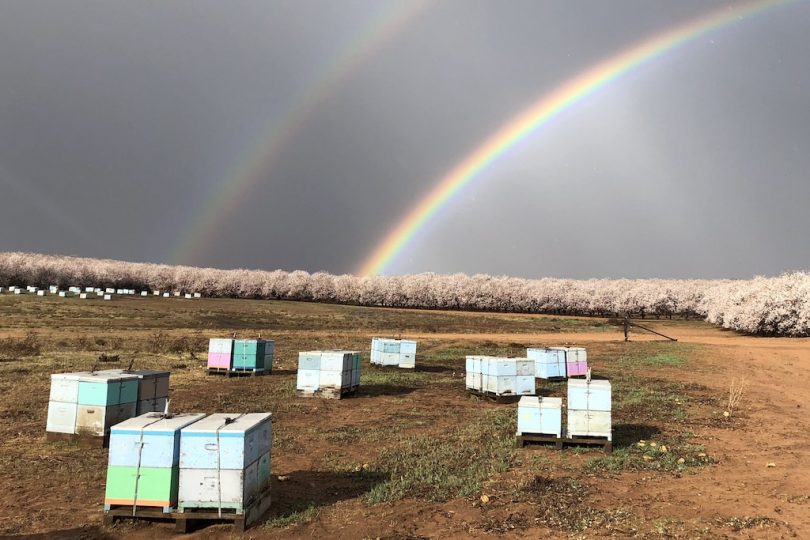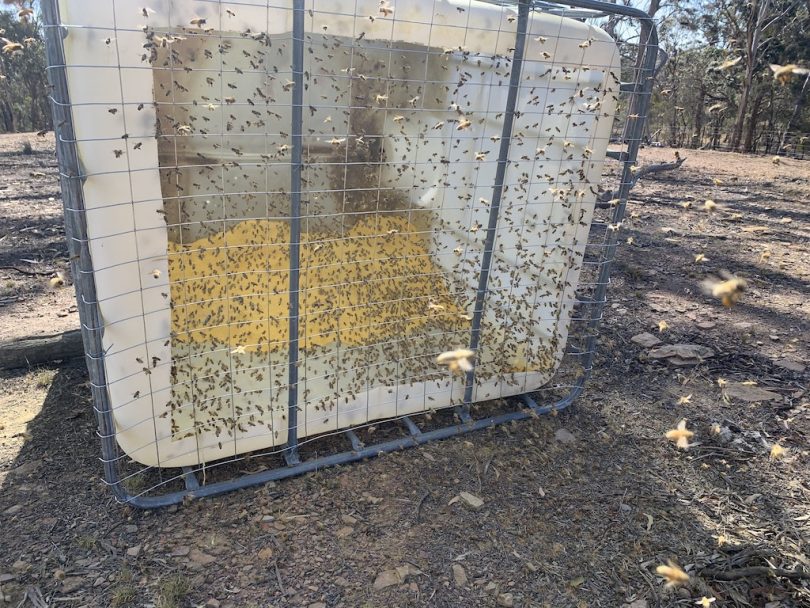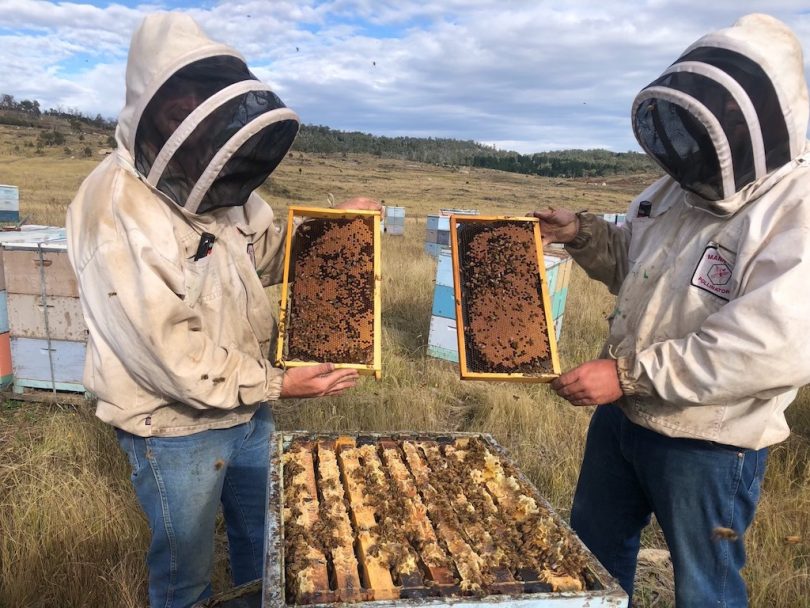
The Kershaw family’s bees were relocated to pollinate almond orchards at Belvedere Almond Farm. Photo: Laurie Kershaw.
After scrambling to rescue thousands of honey beehives from the horrendous Black Summer bushfires that tore through the NSW South Coast’s eucalyptus forests in 2019-2020, the Kershaws are slowly recovering. Drought-breaking rain has helped revive pastures and nourish many of their bees.
But Gundaroo beekeepers Laurie Kershaw, his brother Arthur, and sons James, Matthew and Grant, worked frantically to get through their ordeal. After multiple trips to and from the South Coast, they carried many of the rescued hives to land near Bredbo, only to have to lift all of the hives quickly once more when fires from the ACT raced with the wind southwards.
“They were our worst [affected] bees,” says Laurie. “Every time we picked them up we lost bees out of them.”
At Jugiong, on the Murrumbidgee River, the family’s nucleus hives containing queen bees were smothered in thick smoke from the Tumut-Batlow bushfires. Many had been dehydrated. Some got lost and dwindled away in the smoke.
So scarce were suitable flowering trees and pastures after the fires, the Kershaws fed their honey bees with a vegetable protein powder imported from the US. Every four days, 40kg of the protein powder per 120 hives were fed to weary worker bees.
The bees gathered the powder on their legs to haul back to their hives. This trying regime continued for three months to nourish the bees.
Thankfully, drought-breaking rain arrived, and a new variety of canola at West Wyalong flowered in late July, offering a little respite for bees and their keepers.
“We didn’t get a great lot of honey off it because the bees were down in strength,” says Laurie. “We were down in numbers, too. During winter, they dwindled away and some hives just didn’t make it.”

Bees collecting protein powder during the drought after the Black Summer bushfires. Photo: Laurie Kershaw.
The long drought had left paddocks without large numbers of sheep and cattle. This allowed new varieties of clover and weeds to thickly blanket paddocks once they were soaked with rain and offer another lifeline for hungry bees.
The Kershaws brought some bees back to the Jugiong district around November 2020, where they were able to get nourishment from river red gums, arrowleaf clover and lots of Scotch thistles, towards Harden.
Laurie says earlier this year, mugga ironbark at West Wyalong flowered, creating honey flows in national parks, state forestry, travelling stock routes and private properties.
“The ironbark responded after the drought, turning on a short budding in March, earlier than April when it was expected for some reason – I think it was the rain pattern,” he says.
“We were able to take all of the honey off the bees and they built a box [of stored honey] over winter. At this stage, coming out of winter, the bees are looking good, ready for almonds [pollination].”
Laurie is expecting flourishing canola crops at West Wyalong to provide good flowering across widespread fields. As well, the Kershaws will take about 1200 hives to Belvedere Almond Farm orchards in the Narrandera and Darlington Point districts (Murrumbidgee Irrigation Area). Almonds need 100 per cent honeybee pollination to set the nuts.
Meanwhile, revisiting the South Coast’s once majestic forests has been heartbreaking for the regional beekeepers. The fire-ravaged trees are not expected to offer any flowering for bees for the next five to 20 years due to the intensity of the Black Summer fires.
Among the forests, at least 10 major eucalyptus species produce pollen and honey for honeybees, but the fires damaged each variety to varying degrees, depending on their locations.

Matthew and Grant Kershaw attending to beehives. Photo: Supplied.
“Some will recover quicker than others, but unfortunately some species won’t recover at all,” says Laurie.
Commercial apiarists also have to contend with COVID-19 restrictions. Classed as essential agricultural workers, beekeepers still must negotiate with authorities to cross state borders, and isolated landholders are reluctant to admit strangers onto their land for fear of the virus.
“Our main income is selling honey, and people can support Australian beekeepers when they buy 100 per cent Australian honey,” says Laurie.
You can help bees by becoming a ‘friend’ through a voluntary contribution to the Australian Honey Bee Industry Council which works to promote and protect the Australian honey bee industry.
Visit the Australian Honey Bee Industry Council website or Facebook page.
Original Article published by John Thistleton on The RiotACT.







